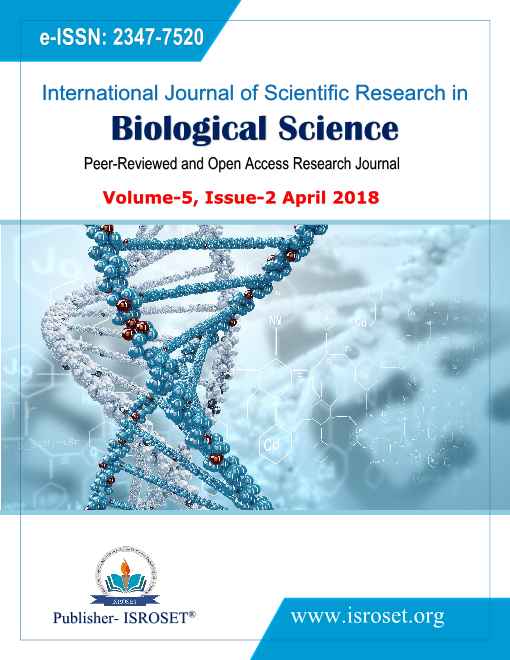Purification and Electrophoretic analysis of Extracellular Alkaline Phosphatase from bulb extracts of Urginea species
Keywords:
Urginea, Alkaline Phosphatase, Purification, SDS-PAGEAbstract
Alkaline phosphatase was purified from three species of Urginea collected from different regions of India, Urginea wightii (Yediyur), Urginea indica(Karwar) and Urginea polyphylla (Castle rock Poona). The procedure followed for purification were Salt precipitation, Dialysis, ion exchange and Gel filtration method. Lowry’s method was used to estimate the Protein concentrations. The purified enzyme was subjected to 12.5% SDS-PAGE for molecular determination of Urginea species. The molecular weight of the protein band obtained was nearly 46 kDa in Urginea indica but Urginea wightii and Urginea polyphylla the protein band obtained was approximately 43kDa. The enzyme activity in these three-species varied. In Urginea indica it was found to be more about 0.152 U/ml while in Urginea wightii showed 0.05U/ml enzyme activity and 0.106 U/ml. in Urginea polyphylla.
References
Lianna Munson and R.Ray fall, “Purification and characterization of Escherichia Coli alkaline phosphatase. A biochemical experiment. Biochemical education”, Volume 6, Issue 3, pp.53-56, 1978.
A.Faiza Ali and B. Nada Hamza, “Purification and characterization of alkaline phosophatase enzyme from the periplasmic space of Escherichia coli C90 using Different method”, African crop science Journal, Volume 20, Issue 2, pp.125-135,2012.
J.L. Millan,” Alkaline phosphatases: structure, substrate specificity and functional relatedness to other members of a large superfamily of enzymes, Purinergic Signalling”. via Springer, Volume 2, pp. 335–341, 2006.
H.K. Airy shaw, “Diagnosis of new families, new names etc. for the seventh edition of wills Dictionary” Kew Bull, Volume 18, pp.249-273, 1964;
D.B. Deb, S. Dasgupta, “On the identity of three new species of Urginea(Liliaceae”, Journal of Bombay Natural History society, Volume 84, Issue 2, pp.409-412, 1987.
E Bernt, “Methods of Enzymatic Analysis (Bergmeyer HU, editor) 2nd edition”, Volume 2, pp.868-870, 1974.
O.H. Lowry, N. J. Rosebrough, A.L. Farr, and R.J. Randall, “Protein measurement with Folin-Ciocalten’s reagent”, Journal of Biological Chemistry, Volume 193, pp. 265-275, 1951.
A.W. Hodson, and A. Latner, “Isoenzymes of Alkaline Phosphatase”. British Medical Journal Website:pubmed central.nih.gov ,Volume 2 ,pp. 5243-246, 1961.
G. Greene, H. Radhakrishna, and R. Tannenbaum, “Protein binding properties of surface modified porous polyethylene membranes”. Biomaterials Volume 26, pp.5972-5982, 2005.
Laemmli UK. “Cleavage of structural proteins during the assembly of the head of bacteriophage T4”, Nature, pp. 227: 680, 1970.
S.A. Miller, D.D.Dykes and H.F.Polesky, “A Simple Salting Out Procedure for Extracting DNA from Human Nucleated Cells”, Nucleic Acids Res., Volume 16, Issue 3, pp. 12-15,1988.
Vemuri Praveen Kumar et al. “Characterization studies of thermostable alkalinephosphatase from various plant seeds”, Journal of Applied Biosciences, Volume 36, pp.2403- 2408 ,2010.
Fajana Olusegun et al. “Characterization of Alkaline Phosphatase (E.C 3.1.3.1) From the Seeds of Dacryodes Edulis (African Pear) A Likely Industrial Source for Enzyme Production”, International Journal of Engineering and Science, Volume 2 Issue 4, pp.31-36, 2013.
Lorena Morales et al. “Purification and Characterization of an Alkaline Phosphatase Induced by Phosphorus Starvation in Common Bean (Phaseolus vulgaris L.) Roots”, J. Mex. Chem. Soc, Volume 56, Issue 1, pp. 80-84, 2012.
M. Mahesh, R. somashekhar, Preenon Bagchi and E.T. Puttaiah, “Optimization for the production of Extracellular Alkaline Phosphatase from Proteus mirabilis”, Bioprocessing and Biotechniques, Volume 5, Issue 3, pp.1-5,2015.
Richa Tiwari Geetika Bakshi2, Niranjan Tiwari1 and Nitin Puranik “Production, Purification and efficacy determination of Epsilon toxin from Clostridium perfringens type ‘D’IVRI native culture”, International Journal of Scientific Research in Biological Sciences, Volume 2, Issue 2,pp.01-04,2015.
Downloads
Published
How to Cite
Issue
Section
License

This work is licensed under a Creative Commons Attribution 4.0 International License.
Authors contributing to this journal agree to publish their articles under the Creative Commons Attribution 4.0 International License, allowing third parties to share their work (copy, distribute, transmit) and to adapt it, under the condition that the authors are given credit and that in the event of reuse or distribution, the terms of this license are made clear.







